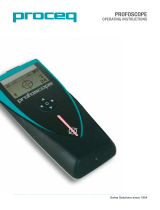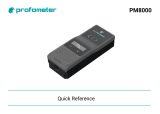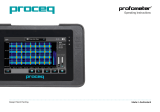
k) The warnings shown in the display must always
be observed.
l) Do not use the tool in the proximity of electro-
magnetic interference (e.g. electric breakers in
operation).
m)Take the influences of the surrounding area into
account. Do not use the tool where there is a risk
of fire or explosion.
n) Make sure that the display area can be easily
read (e.g. do not touch the display area with the
fingers, keep the display area clean).
o) Do not use the tool if it is defective.
p) Always keep the detection area clean.
q) The accuracy of the tool is influenced by the base
material. If the tool is unable to calibrate itself
correctly, scanning errors may result.
r) When the tool is unable to calibrate itself automat-
ically, a warning appears in the display.
s) Use of the tool in the proximity of persons with a
cardiac pacemaker is not permissible.
4.2 Proper organization of the workplace
a) Avoid unfavorable body positions when working
on ladders or scaffolding. Make sure you work
from a safe stance and stay in balance at all
times.
b) When the tool is brought into a warm environ-
ment from very cold conditions, or vice-versa,
allow it to become acclimatized before use.
c) Use the tool only within its specified limits.
d) Observe the accident prevention regulations ap-
plicable in your country.
4.3 Electromagnetic compatibility
Although the tool complies with the strict require-
ments of the applicable directives, Hilti cannot en-
tirely rule out the possibility of the tool being subject
to interference caused by powerful electromagnetic
radiation, leading to incorrect operation. Check the
accuracy of the tool by taking measurements by other
means when working under such conditions or if you
are unsure. Likewise, Hilti cannot rule out the pos-
sibility of interference with other devices (e.g. aircraft
navigation equipment). The tool complies with the
requirements of class A; The possibility of interfer-
ence occurring in a domestic environment cannot be
excluded.
4.4 General safety instructions
a) Check the condition of the tool before use. If the
tool is found to be damaged, have it repaired at
a Hilti service center.
b) The user must check the accuracy of the tool
after it has been dropped or subjected to other
mechanical stresses.
c) Although the tool is designed for the harsh con-
ditions of jobsite use, as with other measuring
instruments it should be treated with care.
d) Although the tool is protected to prevent entry
of dampness, it should be wiped dry each time
before being put away in its transport container.
e) Check to ensure that all symbols are visible when
the tool is switched on.
f) Check the accuracy of the tool before using it for
detection or measurement.
4.5 Electrical safety
a) Keep the batteries out of reach of children.
b) Do not allow the batteries to overheat and do not
expose them to fire. The batteries may explode or
release toxic substances.
c) Do not charge the batteries.
d) Do not solder the batteries into the tool.
e) Do not discharge the batteries by short-
circuiting. This may cause them to overheat and
present a risk of personal injury (burns).
f) Do not attempt to open the batteries and do not
subject them to excessive mechanical stress.
4.6 Transport
Always remove the batteries before shipping the
tool.
en
15















